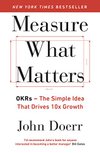
Saved by Eric Johnson and
Measure What Matters: OKRs: The Simple Idea that Drives 10x Growth

Saved by Eric Johnson and
Objectives and key results are the yin and yang of goal setting—principle and practice, vision and execution. Objectives are the stuff of inspiration and far horizons. Key results are more earthbound and metric-driven. They typically include hard numbers for one or more gauges: revenue, growth, active users, quality, safety, market share, customer
... See moreThis is the direction we want to go, now tell us how you’re going to get there. Those
Now, what’s wrong with this picture? Here’s a clue: The SVP’s key results are a mess. Unlike the head coach’s KRs, they’re unmeasurable. They’re not specific or time bound.
Superpower #1—Focus and Commit to Priorities (chapters 4, 5, and 6): High-performance organizations home in on work that’s important, and are equally clear on what doesn’t matter. OKRs impel leaders to make hard choices. They’re a precision communication tool for departments, teams, and individual contributors. By dispelling confusion, OKRs give us
... See moreOKRs surface your primary goals. They channel efforts and coordination. They link diverse operations, lending purpose and unity to the entire organization.
I’ve worked for some great leaders in my day. They were all very different, but one thing they had in common was this cold, sober focus. If you sat down with them for twenty minutes, they were completely uncluttered in their thinking. They could drill down very clearly on what needed to be done.
Stay flexible. If the climate has changed and an objective no longer seems practical or relevant as written, key results can be modified or even discarded mid-cycle. (See chapter 10, “Superpower #3: Track for Accountability.”)
Where an objective can be long-lived, rolled over for a year or longer, key results evolve as the work progresses. Once they are all completed, the objective is necessarily achieved. (And if it isn’t, the OKR was poorly designed in the first place.)
Each morning, I’d say to myself, “These are my three buckets, and what am I doing today to move the company forward?” That’s a great question for any leader, with or without a learning issue.